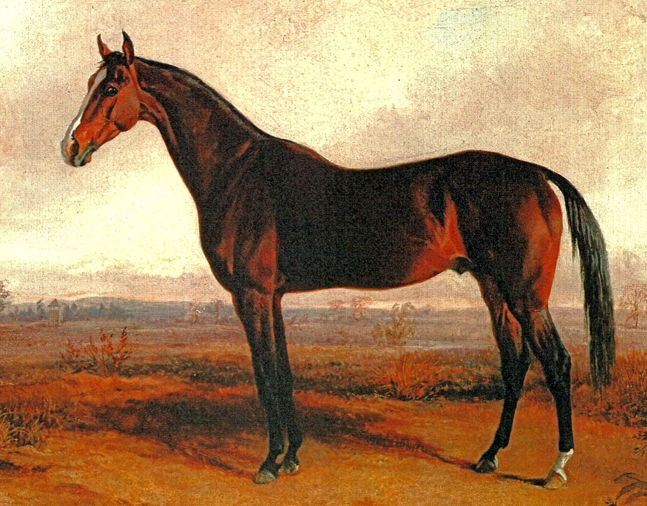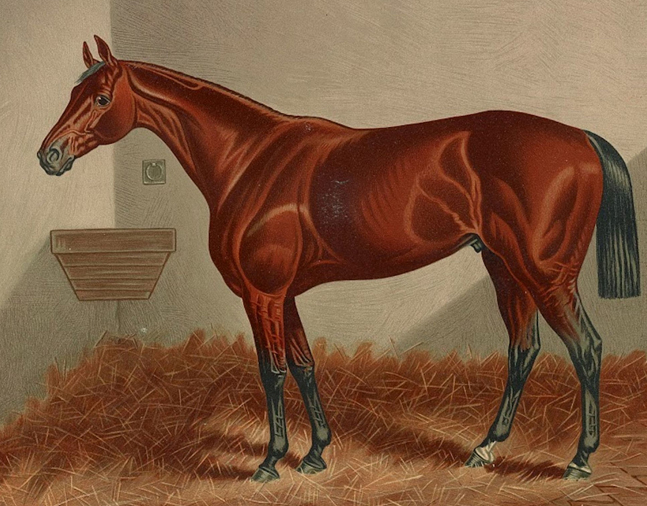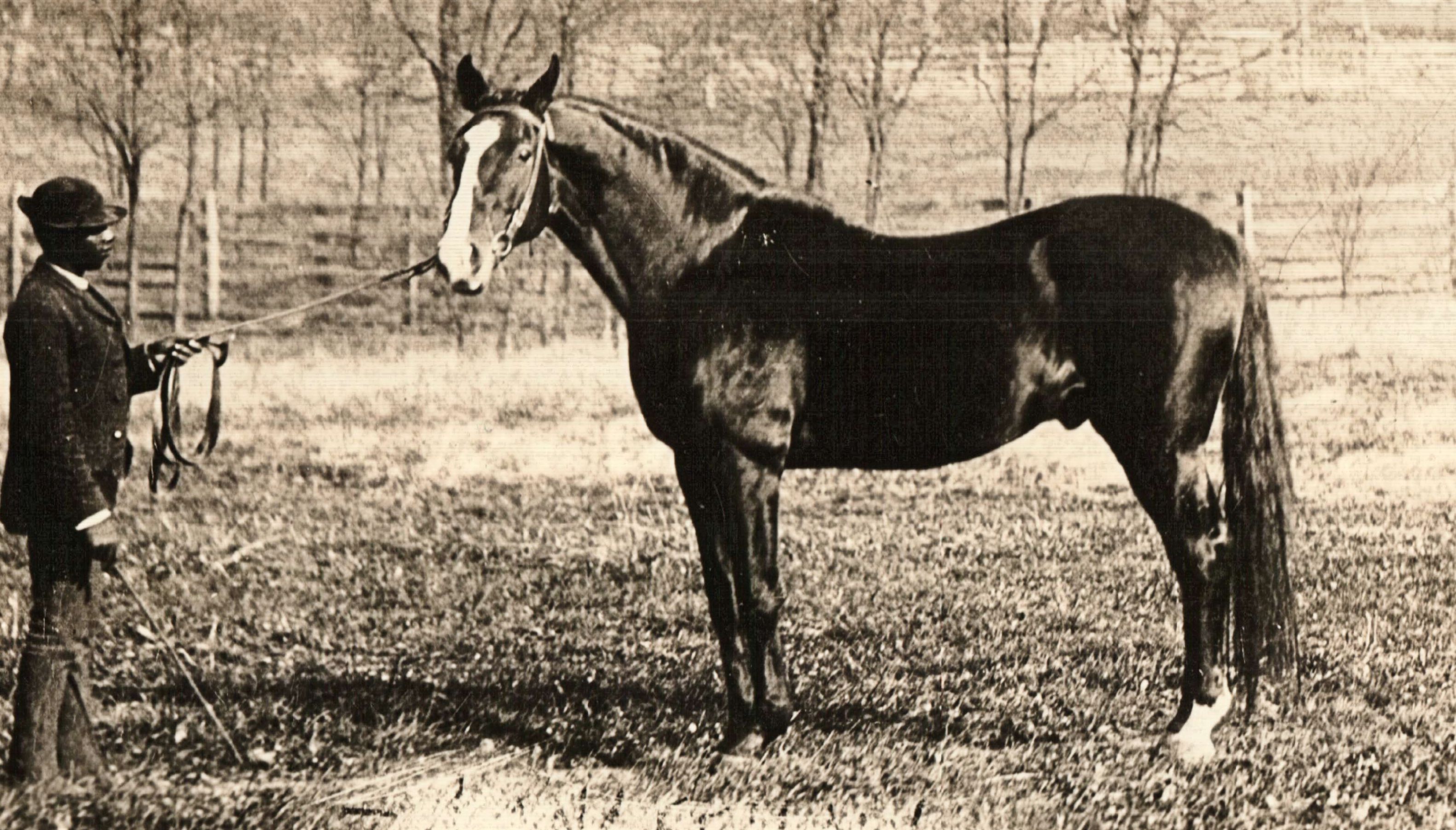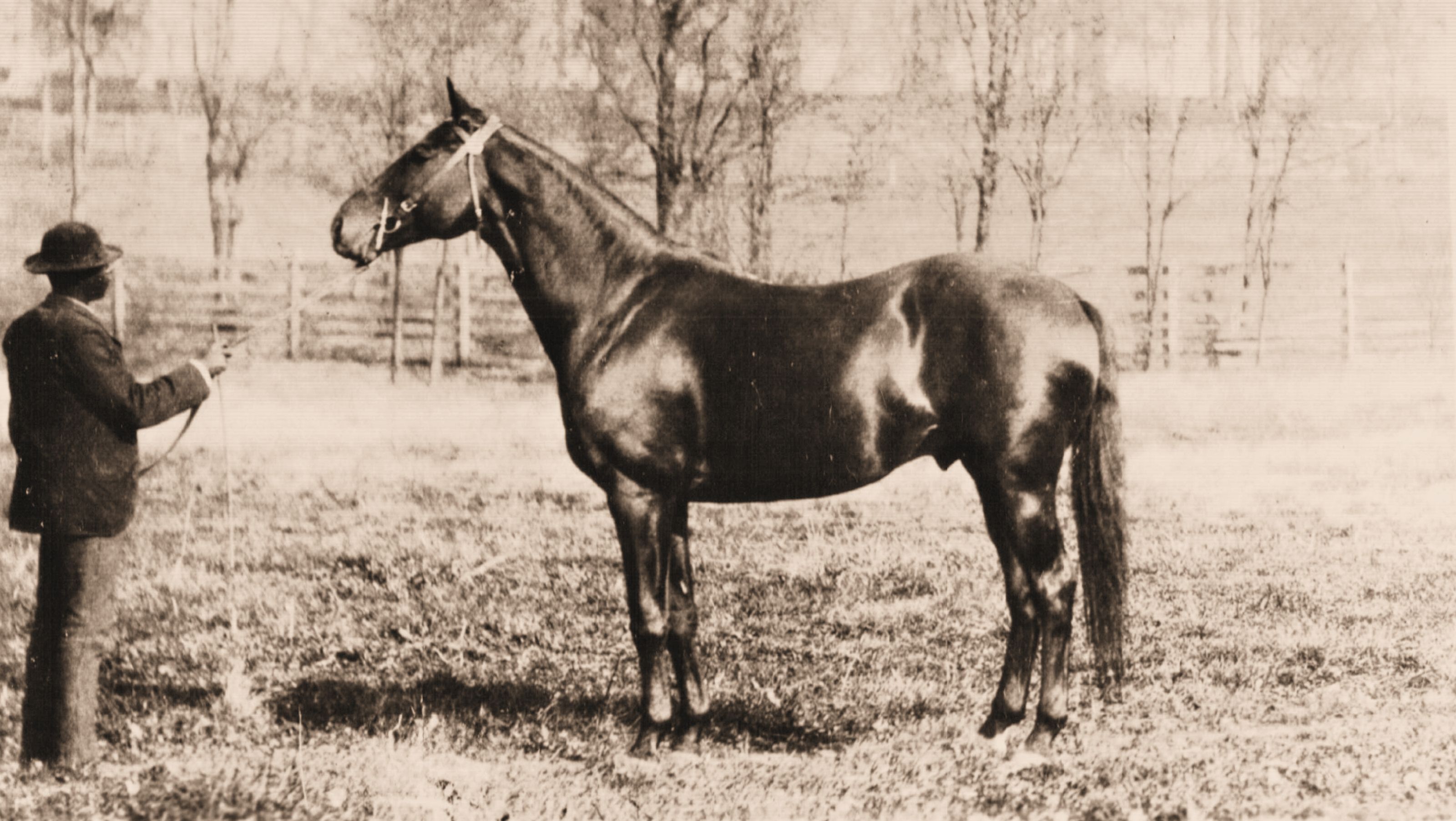An old Kentucky legacy: The mighty Longfellow and Ten Broeck


Hall of Fame members from Nantura Stock Farm were among the best of the 19th century
By Brien Bouyea
Hall of Fame and Communications Director
Longfellow and Ten Broeck, two of the most accomplished and celebrated American racehorses of the 19th century, will forever be linked even though they never crossed paths on the racetrack during their remarkable careers.
Representing the Harper family’s Nantura Stock Farm, located near Midway, Kentucky, Longfellow and Ten Broeck had few peers during their respective runs of dominance in the 1870s. Longfellow, known as the “King of the Turf,” came along first, winning 13 of his 16 starts from 1870 through 1872. Ten Broeck, meanwhile, made his debut in 1875 and won 23 of his 29 races. He reeled off 15 consecutive victories at one point and set six American records at distances ranging from one to four miles by the time he retired in 1878. Both Longfellow (1971) and Ten Broeck (1982) were eventually elected to the Hall of Fame.
Nantura and the Harpers were the common threads that tied Longfellow and Ten Broeck together. The renowned farm was established in 1795 by Jacob Harper when he purchased 700 acres in Woodford County that adjoined Robert Alexander’s Woodburn Stud. Upon Harper’s death, his son, John, took command at the farm and named it Nantura in honor of one of his broodmares. John Harper must have recognized he had something special in the equine Nantura, as she later became the dam of Longfellow.
Longfellow — “King of the Turf"
Foaled at Nantura on May 10, 1867, Longfellow (Leamington¾Nantura, by Brawner’s Eclipse) was a huge brown colt that grew to be almost 17 hands. Harper, who bred, owned, and trained Longfellow, considered the giant colt too ungainly for either training or racing as a 2-year-old. Finally making his debut in April 1870 at the Kentucky Association track in Lexington. Longfellow was defeated by the champion Enquirer and did not race again until the fall. Upon his return, Longfellow won the Produce Stakes at Lexington on Sept. 16 to break his maiden. Two weeks later, he was shipped to Cincinnati and won the Ohio Stakes. Sent to Tennessee that October, he won the Citizens’ Stakes at Nashville and the Post Stakes at Memphis to conclude his campaign.
As a 4-year-old in 1871, Longfellow emerged as the best racehorse in America. After a walkover in May, he was shipped to Monmouth Park to contest the second running of the Monmouth Cup in July. Facing the champion handicapper Helmbold and the outstanding Preakness proved to be no challenge for Longfellow, as he won in a canter, covering the 2½ miles in 4:41¼. Nine days later, Longfellow met Kingfisher in the Saratoga Cup. Kingfisher was highly regarded and accomplished, having won the Belmont and Travers in 1870. He was no match for Longfellow.
Charles Wheatly, the race starter at Saratoga, said, “I shall never forget it. When the flag fell, Kingfisher shot away. As he did so, the big brown horse wheeled and gathered himself for a spring. He seemed to rise to an awful height, then he sprang forward, and in a twinkling he was in front.”
It was that easy for Longfellow. Following the race, he was dubbed “King of the Turf” in the sporting press. Longfellow’s 5-year-old campaign was defined by his rivalry with the 4-year-old standout Harry Bassett, winner of 14 in a row, including the Belmont, Jersey Derby, Travers, and Kenner. The showdown was scheduled for the Monmouth Cup on July 2, 1872. It wasn’t much of a showdown, as Longfellow crushed the sulking Harry Bassett’s spirit and galloped home to win by an estimated 100 yards.
The rematch was on in the Saratoga Cup, but misfortune ruined Longfellow, as he somehow struck the quarter of his left forefoot and twisted his plate going to the post. Harry Bassett took the early lead and it was apparent something was amiss with Longfellow. Despite racing in excruciating pain, Longfellow pushed Harry Bassett to his limit. In the end, Longfellow came up just short in a heroic performance. Harry Bassett won in 3:59, the fastest 2¼ miles ever raced up to that time.
Longfellow limped back to the judges’ stand, “his progress marked by only three hoofprints.” The twisted plate had been bent double and was embedded in the foot, which was mutilated. With tears streaming down his face, Harper draped a blanket over the back of Longfellow and took him home to Nantura. He was retired with a record of 13-2-0 from 16 starts and earnings of $11,200.
At stud, Longfellow became America’s leading sire in 1891. He sired 42 stakes winners, including five champions. His best son was The Bard, winner of 25 stakes, including the Preakness. Other standouts sired by Longfellow included Kentucky Derby winners Leonatus and Riley, Travers winner Long Dance, and two Kentucky Oaks winners.
Ten Broeck — the record-setter
On June 29, 1972, just two days before Longfellow blistered Harry Bassett in the Monmouth Cup, a colt was foaled at Richard Ten Broeck’s Hurstbourne Stud near Louisville. The bay son of Phaeton out of the Lexington mare Fanny Holton was bred by John Harper, who understandably was otherwise occupied with matters in New Jersey at the time. Given the name Ten Broeck in honor of Hurstbourne’s owner, the equine Ten Broeck became Nantura’s second elite runner of the decade.
Unfortunately, John Harper never got the opportunity to see the greatness of Ten Broeck. Harper died prior to the colt’s racing career and willed his entire estate to a nephew, Frank B. Harper, who maintained Nantura’s reputation in racing and breeding.
Ten Broeck debuted as a 3-year-old on May 10, 1875, in the historic Phoenix Hotel Stakes at Lexington. Ten Broeck was an easy winner in a field of six, which also included Aristides. A week later, Aristides turned the tables by winning the inaugural Kentucky Derby at Churchill Downs. Ten Broeck finished fifth and was rested until the fall. After finishing fifth in a six-horse field in his return, Ten Broeck began to figure things out and set out on a path to stardom. He established the first of his records on Sept. 9, covering 1⅝ miles in 2:49¼, lowering the American record by 3¾ seconds. Ten Broeck added wins in the Post Stakes, Merchants’ Post Stakes and the Maxwell House stakes that autumn.
Ten Broeck began his 4-year-old season in 1876 by finishing second to old nemesis Aristides once again. Aristides set an American record of 3:34½ for 2⅛ miles in the process. It was the only defeat of the year for Ten Broeck, winner of his next 15 starts. His 1876 victories included the Louisville Cup and Galt House Plate in May and three American records in the fall. At the Lexington track in September, Ten Broeck covered 2⅝ miles in 4:58½. He followed that a week later at Churchill in the Post Stakes by lowering the American mark for three miles to 5:26½. Four days later, Ten Broeck broke Fellowcraft’s four-mile record, clocking in at 7:15¾, almost four seconds better than the previous standard.
Competition was scarce for Ten Broeck as a 5-year-old. On May 24, 1877, he set a new American record for one mile (1:39¾) at Churchill. Five days later, Churchill management offered Harper half the gate if Ten Broeck could beat True Blue’s American record of 3:32½ for two miles. Ten Broeck delivered, smashing the mark by five seconds for his sixth American record. He added four more wins in the fall to extend his win streak to 15.
Ten Broeck’s streak was snapped in his next race, a showdown with Parole and Tom Ochiltree at Pimlico on Oct. 26, 1877. Heavily favored, Ten Broeck finished second to Parole in one of the most celebrated races of the century. Ten Broeck immediately returned to his winning ways two days later by winning the Bowie Stakes in four-mile heats. He won in dominant fashion in 7:42½ and 7:40, distancing his overmatched rivals, including Belmont Stakes winner Algerine. A scheduled rematch with Parole fell through when Harper was not pleased with Ten Broeck’s training.
Continuing to compete as a 6-year-old in 1878, Ten Broeck won a sweepstakes at Lexington in May, defeating his old nemesis Aristides. He met one more challenge, the 5-year-old California mare Mollie McCarthy, in a match race at Churchill on July 4 before a crowd of more than 25,000. The $10,000 purse was the richest event of Ten Broeck’s career. The contest was not expected to be easy, as Mollie McCarthy was undefeated in 13 starts. Ten Broeck, however, handled the great mare with ease, distancing her in the first four-mile heat to win the race.
Ten Broeck was retired after his brilliant effort against Mollie McCarthy. His final victory became the subject of folk songs throughout Kentucky. Standing stud at Nantura alongside Longfellow, Ten Broeck sired Travers winner Bersan, Kentucky Oaks winner Ten Penny, Tennessee Derby winners Ten Strike and Jim Gray, and Alabama winner Tolu.
The Legacies
On June 28, 1887, Ten Broeck died at the age of 15. Turf, Field and Farm reported: “Longfellow lives, but Ten Broeck is dead. The daughters of producing lines which neigh for the son of Phaeton are answered by silence. A great horse, wearing a name distinguished in the annals of the turf, has passed away, and no one would blame Frank Harper if he should put crape on his hat.”
Longfellow died six years later on Nov. 5, 1893, at the age of 26. The Live Stock Record wrote: “Longfellow has served his day well, and died full of honors, but his name, through his descendants, will long be kept fresh in the minds of turfmen.”
The two immortal sons of Nantura were buried in adjacent graves on the farm where they were foaled and raised. Their tombstones are the oldest equine markers in Kentucky. Nantura is no longer a thoroughbred farm, as cattle graze the land today, but the grand stone obelisks memorializing Longfellow and Ten Broeck remain. Visitors still occasionally stop by the property to pay their respects to the ancient legends of the turf.
The monuments honoring Longfellow and Ten Broeck have endured through the procession of time, as have the legacies of the remarkable runners that permanently rest in the soil beneath.
Longfellow (KY)

Lifespan: 1867 ̶ 1993
Pedigree: Leamington—Nantura, by Brawner’s Eclipse
Breeder: John Harper
Owner: John Harper
Trainer: John Harper
Career dates: 1870 ̶ 1872
Record: 16 starts, 13 wins, 2 seconds, 1 third
Earnings: $11,200
Honors:
- Champion Handicap Male 1871
- Horse of the Year 1872
- Co-Champion Handicap Male 1872
- Inducted into the Hall of Fame 1971
Notable:
- Won the Ohio Stakes 1870
- Won the Monmouth Cup 1871
- Won the Saratoga Cup 1871
- Won the Monmouth Cup 1872
- Sired Kentucky Derby winners Leonatus and Riley, as well as champions Longstreet, The Bard, and Thora, among others
Ten Broeck (KY)

Lifespan: 1872 ̶ 1887
Pedigree: Phaeton—Fanny Holton, by Lexington
Breeder: John Harper
Owner: Frank B. Harper
Trainer: 1. Harry Colston; 2. Frank B. Harper
Career dates: 1874 ̶ 1878
Record: 29 starts, 23 wins, 3 seconds, 0 thirds
Earnings: $27,550
Honors:
- Co-Champion Handicap Horse 1876
- Co-Champion Handicap Horse 1877
- Inducted into the Hall of Fame 1982
Notable:
- Won the Phoenix Hotel Stakes 1875
- Won the Louisville Cup 1876
- Won the Bowie Stakes 1877
- Set six American speed records
- Simultaneously held the American records for one, two, three, and four miles
- Sired Travers winner Bersan, Kentucky Oaks winner Tenpenny, and Tennessee Derby winners Ten Strike and Jim Gray




